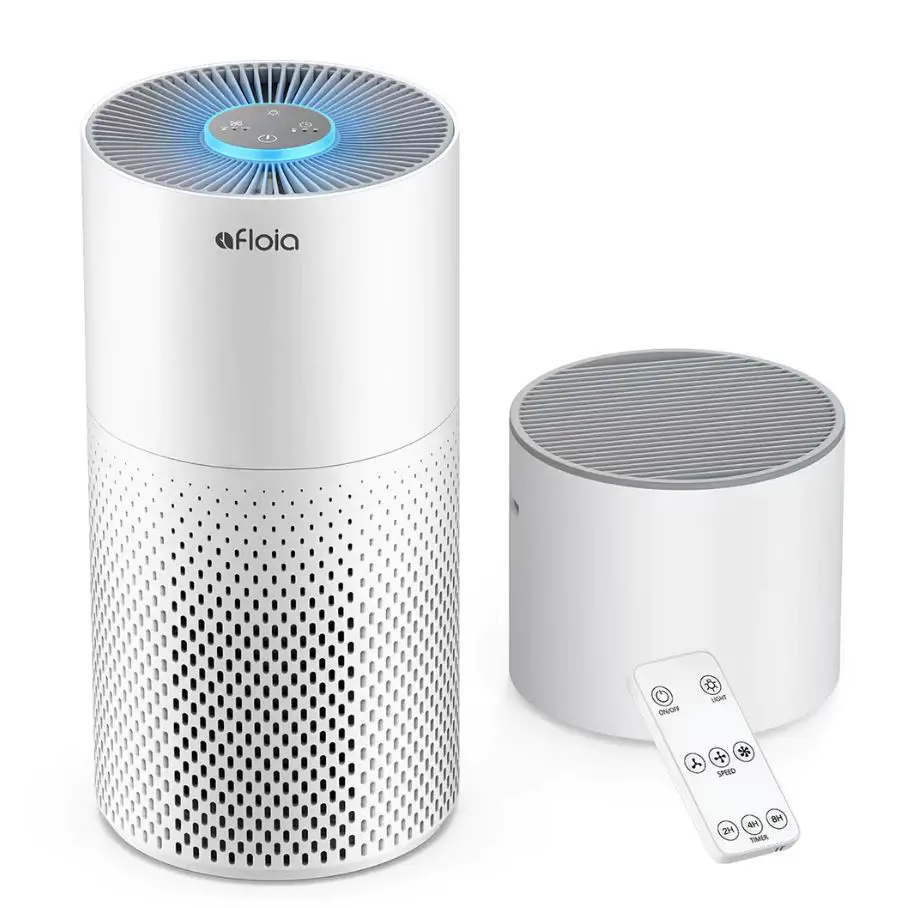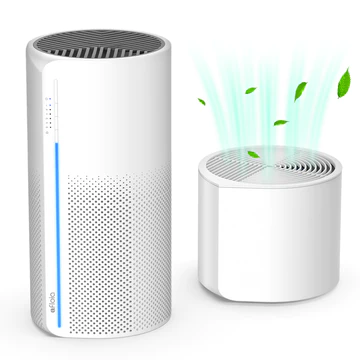More than 135 million of us breathe toxic air in every single day. Dry air can further compound this problem.
A humidifier and air purifier can be used simultaneously in the same space to improve air quality. However, the two devices should be placed at least 3 feet apart to prevent the air emitted from the humidifier directly entering the air purifiers inlet.
This article explains how humidifiers and air purifiers can be used together, and whether or not combination units are a better option.
- Two-in-one devices with air filtration and humidification functions are preferable to save space, money, and energy.
- Humidifiers increase humidity levels to 30-50%.
- Air purifiers clean the air by removing pollutants, allergens, dust, bacteria, and odors.
Using a Humidifier and an Air Purifier Together
Humidifiers and air purifiers can be used together in a room without causing any problem.
Air purifier filters can usually withstand a wide range of humidity levels and will remove pollutants from the air, without influencing the moisture.
You can read more about how air purifiers affect humidity here.
You can set up both devices separately and run them at the same time. However, running a humidifier and air purifier in the same room can be problematic if they are placed too closely together.
It’s best to place both the devices at opposite ends of the room or at least at 3 feet away so that the humidifier’s outlet does not direct towards the air purifier’s air inlet.
Otherwise, humidity levels in the filter will rise, clogging them and encouraging microbial growth, rendering your air purifier useless.
You may not always need to run an air purifier and a humidifier together. However, in the dry winter season, the combination of purifiers and humidifiers can provide a perfectly humid and clean atmosphere to breathe.
Both devices can also help combat the allergy seasons; for example, air purifiers can remove allergens, and humidifiers can add moisture to dry air, which helps reduce the symptoms of allergies.
A better alternative to using two separate devices is a two-in-one device with both a humidifier and an air purifier.
Two-in-One Humidifiers and Air Purifiers
In the past, if you wanted to use a humidifier and air purifier, you had to buy two separate units, a humidifier for maintaining moisture levels and an air purifier to remove pollutants from the air.
There are two-in-one humidifier and air purifier devices now available that can be used together to adjust humidity levels and remove harmful particles from the air, thus improving the overall air quality.
Using a two-in-one humidifier and an air purifier offers several benefits, including cost and energy savings.
There are only a few brands making combination units, and so far we have found the Afloia ones to be the most effective.
Recommended Two-in-One Humidifiers and Air Purifiers
Afloia has two 2-in-1 humidifier and air purifier combination units. These are available on Amazon and directly from afloia.com.
- Kilo Pro
- Miro Pro
Kilo Pro 2-IN-1 Air Purifier & Humidifier

Afloia’s Kilo Pro is a two-in-one upgraded model of the Afloia Kilo that has simultaneous air purification and humidification.
The main body is an air purifier with a detachable humidifier on the top of it.
We like this combo unit because you can also use the air purifier alone when humidity levels are naturally high.
It’s large water tank capacity (1.9L) also means it can completely cover bedrooms, offices, and other rooms up to 270 sq. ft.
The air purifier comes with three layers of filtration (including a pre-filter, HEPA, and carbon filter) and a 360o air inlet for efficient trapping of the particulate matter from the air.
Pros
- Quiet (22dB)
- Sleek and portable design
- Energy efficient
- Large humidifying capacity (150ml/h)
- CADR (150m³/h)
- 2,4,8 and 24 hours timer settings
- CE and FCC certified
Cons
- The unit gets louder when the humidifier is detached.
- You cannot use the humidifier independently.
Miro Pro 2-IN-1 Air Purifier & Humidifier

Afloia’s Miro Pro is a two-in-one purifier and humidifier that can efficiently improve air quality by filtering the air in up to 270 sq. ft in just twenty-four minutes.
The humidifier, with a 1.9L water tank, provides mist-free humidification, and you can add water from the top even while the unit is running.
The air purifier comes with a three-stage filtration system to perfectly remove 99.9% of airborne particles, greatly improving the air quality.
Pros
- Low noise (less than 30dB in low fan speed)
- Three fan speeds (low, medium, and high)
- Three timer options (2,4 and 8 hours)
- Compact and portable
- CADR (150m³/h)
- FCC certified
- ETL listed
Cons
- Filters can be difficult to wash.
Separate Humidifier And Air Purifier Units
If you prefer to have separate humidifier and air purifier units, then here’s some helpful information we have put together on what to look our for in each type.
Humidifiers use water to increase humidity levels, keeping them within the EPA’s recommended range of 30-50% percent, whereas air purifiers use filters to capture particles like dust, smoke, pollen, mold, and other germs.
Some air purifiers can also trap bad smells.
Humidifiers are made to add either cool or warm moisture to the air maintaining the right moisture levels, which if not maintained can lead to dryness and respiratory disorders.
However, air purifiers are designed to decontaminate the air, and they don’t put any moisture into the atmosphere. Instead, they draw air into the unit, filter out any unwanted airborne particles and then release the purified air back into the atmosphere.
Overall, when combined humidifiers and air purifiers improve air quality.
Humidifiers
Humidifiers are often used to ease the dry-air related health issues of throat, nose, lips, and skin as well as other household problems.
Humidifiers work by converting water into water vapors in the form of visible or invisible mist.
Types of Humidifiers
The most common types of humidifiers based on the mechanism of spreading moisture are ultrasonic, impellers, steam vaporizers, and evaporative humidifiers.
1. Ultrasonic use ultrasonic sound vibrations to disperse a cool mist.
2. Impellers generate and disperse a cool mist via a high-speed rotating disk.
3. Steam vaporizers create mist by heating water through electrodes or electrical heating elements.
4. Evaporative humidifiers disperse invisible moisture through a moist absorbent material using a fan.
How to Choose the Best Humidifier
For selecting the best humidifier for your room, look for:
- Size of room
- Water tank capacity
- Run time
- Noise level
Air Purifiers
Air purifiers clean the air by removing pollutants, allergens, dust, bacteria, and odors.
Typically, air purifiers consist of a fan and filters (some have an optional UV-C light). The fan draws in air and circulates it into the machine, passing it through the filter screen, which removes small to large particles (between 0.3 and 10 microns).
The particle removal efficiency of air purifiers depends on the unit model. Different brands indicate the particle removal efficiency as:
- Clean Air Delivery Rate (CADR) rating system
- High-Efficiency Particulate Air (HEPA) filters
- The capability of removing 99.99% of particles as small as 0.3µm
A higher CADR means an air purifier can remove more particles covering a large area. The rating is usually measured at the highest speed of an air purifier, using three different types of pollutants, including smoke, dust, and pollen, to indicate small, medium, and large-sized particles.
The CADR rating standard is used to help the buyers select the best air purifier on the basis of the size of the intended area where it is to be used.
CADR Rating of Portable Air Purifiers for various Room Sizes (Calculations Based on 8-10 Foot Ceiling)
| Room Size (Sq. Ft) | CADR (cfm) |
| 100 | 65 |
| 200 | 130 |
| 300 | 195 |
| 400 | 260 |
| 500 | 325 |
| 600 | 390 |
Types of Air Purifiers
The common types of air purifiers are:
1. HEPA air purifiers use HEPA filters to remove 99.9% of air pollutants
2. Activated Carbon filter-based purifiers come with a highly porous surface that helps them to trap various odors, chemicals, and other small particles.
If you need precise filtration, portable air purifiers with both HEPA filters and activated carbon filters are reported to be the best filters for trapping various small-sized particles. They can control the spread of toxins, bacteria, and mold spores.
How to Choose the Best Air Purifier
To choose the best air purifier, the things that need to be considered are:
- Size of room
- Indoor air quality
- CADR rating
- Type of filter
- Electricity costs
- Certifications
- Noise level
